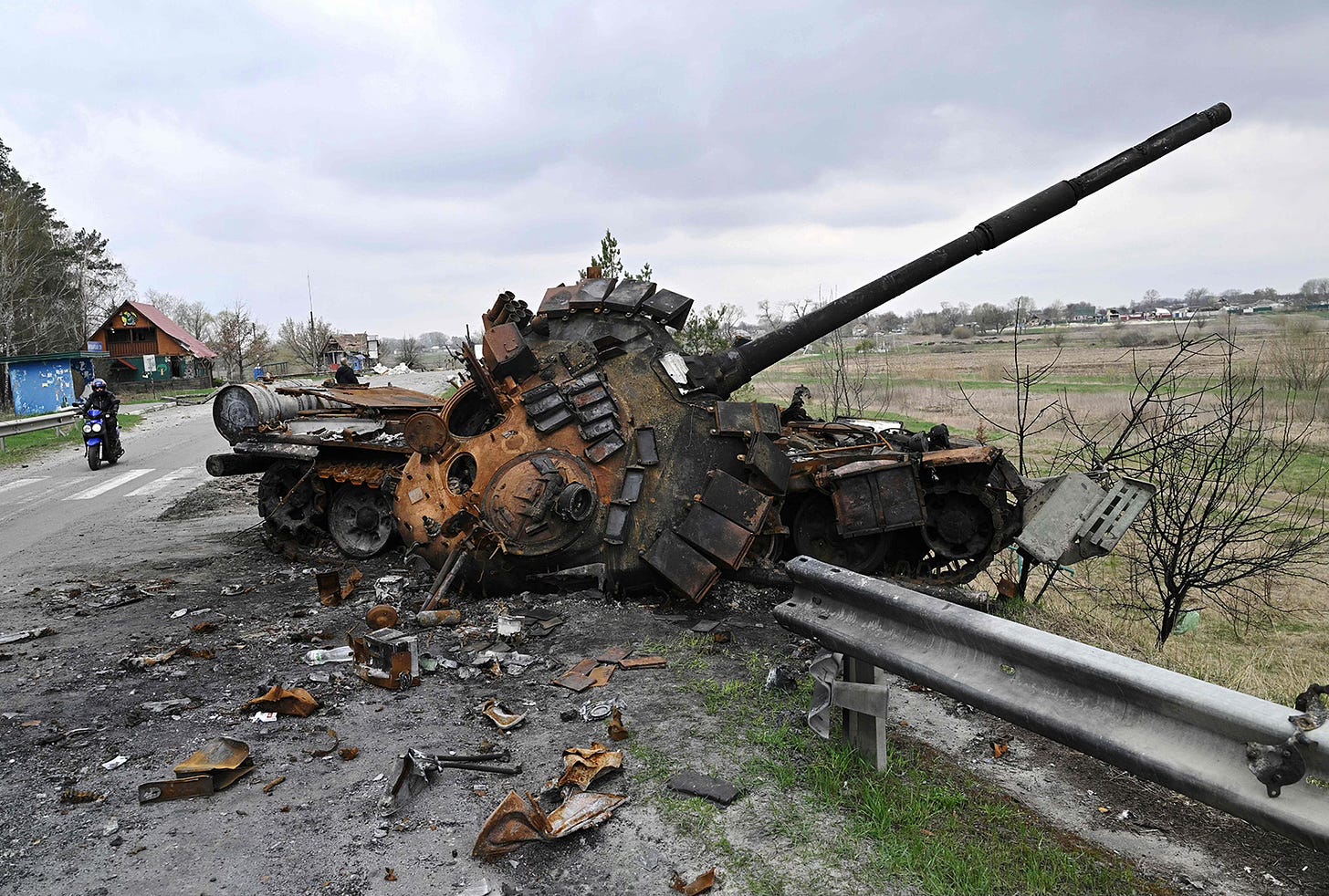MICK RYAN

This is the story of part of a war. It is only part of a war because, at least when this manuscript was completed, the war in Ukraine that was the result of Russia’s invasion of February 2022 remained an active conflict. It is part of a war because, as with all wars, there are many things about it, even in this age of social media and greater battlefield transparency, that are yet to be revealed.
Mick Ryan, The War for Ukraine (2024)
Over the last few days, besides keeping up with events in Ukraine, Gaza and the Western Pacific (my daily strategic scan), I have been busy reviewing the copy edits for my next book. The subject of the book is the war in Ukraine. Tentatively, it will be called The War for Ukraine, and will be published in August 2024 by US Naval Institute Press (who also published my 2022 book, War Transformed).
As my quote above notes, the book tells part of the story of a war that is still underway. In such circumstances, one has to decide which part of the war’s chronology to cover, and where the story must end (for the time being at least). Therefore, my forthcoming book explores the period from the beginning of the Russian large-scale invasion in February 2022 through to 2023 NATO Summit in Vilnius, during which the initial phase of the Ukrainian 2023 counteroffensive was being executed.
The central hypothesis of my forthcoming book is that like many wars, there is an array of factors that have impacted on the course of this war. But there are two factors that I propose have been of overriding importance. These two factors, which provide the framework for my exploration of the war, are strategy and adaptation. It is these two areas where the differences between the approach of the Ukrainians and Russians in this war have been most stark. And arguably, it is these two areas where Ukraine has at times developed an asymmetric advantage over Russia.
Part One of my book is focused on strategy.
The word “strategy” entered the modern European lexicon in the 1770s. The source was the publication of a translation of the Byzantine emperor Leo VI’s Taktiká, by French officer Paul Gédéon Joly de Maizeroy. The translated work included descriptions of strategía. This word was translated as stratégie, and by the early 1800s, European military theorists were using the word “strategy.” Used to describe the higher arts of military planning in early 19th century Europe, strategy has since then transformed in theory and practice.
Since the beginning of the 20th century, the application and meaning of strategy has evolved. Originally applied to the preparation of military organizations for war, it is a word now associated with larger national pursuits, particularly in the wake of the total wars of the twentieth century. And it used across other endeavors not related to national security. Most businesses now have corporate strategies, and it is a word that is used very widely across many of human endeavors.
Sir Lawrence Freedman, an eminent scholar who literally wrote the book on strategy, observes in Strategy: A History that strategy “only really comes into play when elements of conflict are present.” Conflict was present in the lead-up to the war and in the latest Russian invasion of Ukraine in February 2022. And it has existed throughout the war in Ukraine.
There is an important reason that the first part of this book is about strategy. The war in Ukraine offers academics, politicians, military leaders, and civil servants many different observations on the development and execution of strategy from the perspectives of the Ukrainians, Russians, Americans, and others. There are a range of examples of effective strategy development and its implementation from the war in Ukraine since 2022. There are also examples of poor strategy, and terrible execution of strategy.
Russian strategy has been explored by a multitude of government analysts as well as experts in academia and think tanks throughout the Cold War, into the post–Cold War era, and now in what some have described as the post-post–Cold War era. There is a significant body of literature that explores Soviet and Russian strategy over the past seven decades, including nuclear strategy, conventional warfare, and its strategy for confrontation with the West.
Ukrainian strategy in this war has shallower roots. While it possesses a culture and history that extends back centuries, in the modern era it has been a sovereign nation only since 1991. It has only had three decades to develop its contemporary strategy culture and approach to strategy. Despite this, Ukraine has demonstrated an adroit capacity for strategic thinking and action since the Russian 2022 invasion.
The aim of this first part of the book is to explore the Russian and Ukrainian strategy as it has been used since February 2022. Across seven chapters, the Ukrainian and Russian development of strategy, and how their strategies have evolved, will be explored. Part of the exploration of strategy in my book will be the role of leadership. Strategy and leadership are intertwined. Indeed, it is difficult to conceive of one without the other in modern war. The role of civil-military relations is also covered, although I think the examination of Ukrainian and Russian civ-mil relations during the war could be an entire book by itself.
The final chapter in the strategy part of my book provides observations for contemporary strategists. While not a checklist, these observations are a collection of issues that will be of import to current and future strategists. The issues raised in this chapter also provide the starting point for further examination of the strategic elements of this war, and how they might apply to future warfare.
Adaptation
The second part of The War for Ukraine explores the concept and practice of adaptation as it has occurred throughout the war since February 2022.
No government, military organization, or business institution is able to predict the future with any certainty. While trends can be utilized to prepare for “most likely” and “most dangerous” future scenarios, every human organization is surprised to some degree about how future events play out. This has unquestionably been the case for this war as well. Indeed, surprise is an important continuity in all wars, and this war has been no different. The Russians were surprised by the level of Ukrainian resistance and Western support for Ukraine. This necessitated Russian adaptation to their military campaign, where and how their forces fought, and their global narratives about the war.
Many have been surprised by the viciousness of the Russian onslaught—its destructiveness as well as the Russian human wave and Storm tactics, as well as the wide-scale use of Iranian drones against critical infrastructure. But the Ukrainians, facing an existential threat, have demonstrated a learning culture at different levels that not only blunted the Russian invasion in the early days of the war but has also seen them constantly adapt at the tactical, operational, and strategic levels over the course of the war.
This second part of my book examines how Ukrainian and Russian military reforms before the war provided a foundation for their respective adaptive stances during the war. Both nations had undertaken institutional level reforms of their military and national security enterprises in the decade leading up to this war. But because the emergent behavior of military forces after fighting begins cannot be fully predicted, these prewar reforms only form a start point for adaptation during the war.
After examining the intellectual and organisational foundations for Ukrainian and Russian adaptation, the remaining chapters in this part of my book are dedicated to exploring tactical, operational, and strategic Ukrainian and Russian adaptation. There are a myriad of case studies of innovation and change from this war. However, not all innovation results in battlefield success, and this is an important lesson from the war.
Wars are ultimately human endeavors. While machines and information are vital elements in human competition and war, it is humans who decide how these are used, where, when, and in what organizational constructs that ultimately decide victory and defeat. And even if humans now might have their decisions informed and improved by big data and artificial intelligence, humans remain the heart and soul of every government and military system. They drive how institutions learn and adapt.
The final chapter in the adaptation part of my book is a collection of insights and lessons for military and other organizations about institutional learning and adaptation. These are relevant as they can inform our views on the future of war and competition, and how military institutions might prepare for such conflicts.
The War for Ukraine
It is imperative that Western governments, military leaders and public officials learn the lessons from the war in Ukraine. Even though the end of the war remains hidden from us, we cannot afford to wait until then to begin the learning process. This book, hopefully, will contribute to the growing literature about the war and its lessons for contemporary leaders and strategists.
Once I have a confirmed publication date, I will ensure it is published here as well as on my various social media feeds. This book, based on research trips to Ukraine, interviews, many conversations and much research, will hopefully be useful to military and government officials, academics, think tankers and the public.
The war in Ukraine has led to several important transformations in the character of war. I hope the book might help us to better assist Ukraine to win the war, and to ensure Western military institutions are better prepared intellectually, morally, and physically for the challenges of the 21st century.
It goes without saying that while authors work very hard to bring their readers terrific books, the publication staff are also heroes in this process. To that end, I wish to thank the amazing editorial, marketing and administrative staff as US Naval Institute Press. This is my second book with USNI, and the staff are an absolute joy to work with!

No comments:
Post a Comment